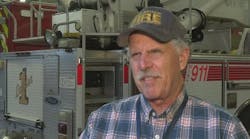FAMA Announces 2014 Scholarship Winner
The Fire Apparatus Manufacturers’ Association (FAMA) has awarded its 2014 Phillip L. Turner Fire Protection Scholarship to California Polytechnic State University, San Luis Obispo student Gary Dominguez.
Dominguez graduated from University of California Santa Cruz (UCSC) with a degree in Business Management and Economics. He is currently a Fire Protection Engineering Graduate Student at California Polytechnic State University, San Luis Obispo, and maintains a 3.925 GPA. He received the $5,000 scholarship in recognition of his outstanding academic achievement and commitment to the fire service. The award is given annually by FAMA and has been sponsored since 2009 by FAMA member Akron Brass Co., a worldwide marketer and manufacturer of high-performance life-safety, firefighting and emergency rescue equipment. A presentation was made at the FAMA Technical Committee meeting in August held in conjunction with the Fire-Rescue International conference in Dallas, TX.
Dominguez wanted to follow in the footsteps of his father, who was a career firefighter and retired as a Fire Chief, but after graduating with a 4-year degree from UCSC he injured his knees prohibiting him from becoming a career firefighter. He now is moving forward with a career in the fire protection field. “His goal is to be a Fire Protection Engineer,” stated Lou Milanovich, FAMA Education Committee co-chair. “The funds from this scholarship will help Gary pay for his schooling to finish his final year of the Fire Protection Engineering MS program at Cal Poly SLO.”
Akron Brass is a proud sponsor of the Phillip L. Turner Scholarship. “Education is a key part of the philosophy at Akron Brass,” said Dave Durstine, vice president at the firm. “We feel it is our responsibility to provide individuals like Gary an opportunity to build the critical skills and knowledge to be successful in life and as leaders within the fire and emergency service industry.”
FEMA Awards Grant to Address Health of Volunteer Firefighters
The University of Texas Health Science Center at Houston (UTHealth) has been awarded a $1.5 million grant from the Federal Emergency Management Agency (FEMA) to test the effectiveness of an online health and wellness program intended to improve volunteer firefighters’ nutrition and fitness and reduce their risk of obesity and cardiovascular disease.
“Volunteer firefighters comprise the majority of the U.S. fire service, yet they are harder to reach than career firefighters for health interventions because they have full time jobs, fire service training requirements and on-call duties,” said R. Sue Day, Ph.D., principal investigator and associate professor in the Division of Epidemiology, Human Genetics and Environmental Sciences at the UTHealth School of Public Health.
The internet and mobile-based health and wellness program, called The First Twenty (TF20), will focus on educating and changing the behaviors of volunteer firefighters about fitness and nutrition. The program was designed by a volunteer firefighter and is built around the firefighters’ lifestyle. Fitness exercises include activities such as carrying a fire hose instead of lifting weights and team events are encouraged to motivate crews and individuals to continually improve their skills. The nutrition program focuses on eating fruits and vegetables, hydration and reducing consumption of processed foods. Firefighters can set goals and log their food intake to instantly receive nutrient amounts and graphs of their intake levels.
The study will recruit volunteer firefighters from across the country for a six-month intervention period. Participants will be able to access TF20 from a phone, computer, tablet or even a CD if internet access is limited. The program will include nutrition information, video workouts, food logs and regular personalized electronic updates or challenges.
In addition to the internet-based program, health coaches will follow up with participants to offer encouragement and advice along the way. Some of the activities will be done as a team, either with firefighters in one location or through internet communication. “The team-oriented culture of fire service is very much embedded in this program,” said Day, who also holds a faculty appointment with the Michael & Susan Dell Center for Healthy Living at the School of Public Health.
Line-of-Duty Deaths
Seven U.S. emergency service personnel recently died in the line of duty. One career firefighter, three volunteer firefighters and three civilian employees died in five separate incidents. Two deaths were health related and five deaths were the results of accidents. One accident involved a medical transport plane and claimed the lives of three civilian employees.
SAFETY OFFICER DOUGLAS JAMES CASSON, 46, of the Vaughn, MT, Fire Department died on Aug. 6. After completing non-physical fire department training on Aug. 5, Casson died a few hours later at home from an apparent heart attack. Casson was a 20-year veteran of the fire service.
CHAPLAIN/FIREFIGHTER DARRELL PARKER of the Fairbury, NE, Rural Fire Department died on Aug. 13. On Aug. 10, Parker was responding to an incident in his private vehicle when it left the roadway, went through a pasture and struck a tree. He was found unresponsive in the vehicle. He was transported to Jefferson Community Hospital and later transferred by helicopter to Bryan LGH West Campus in Lincoln, where he died. Authorities believe that Parker may have suffered a medical emergency before the crash. Parker was a 27-year veteran of the department.
FIRE CHIEF DAVE ANDERSON, 66, of the Fort Shaw, MT, Fire Department died on Aug. 25. On July 22, Anderson was injured in a motor vehicle accident involving two Fort Shaw fire apparatus responding to a brushfire. Anderson was operating a 3,200-gallon tanker that collided with a one-ton brush truck that was making a U-turn on Highway 89 after the driver missed a turn. After the collision, the tanker overturned and Anderson had to be extricated from the wreckage. Anderson was transported to Benefis Hospital and later transferred to other facilities for treatment of traumatic brain injuries. Anderson was a 45-year veteran of the department and served as chief for more than 30 years.
Three flight crew members of Elite Medical Transport in El Paso, TX, died in an airplane crash on Aug. 27. The Cessna 421 was operated by Amigos Aviation of Harlingen, TX. Killed in the crash were PILOT FREDDY MARTINEZ, 29, FLIGHT PARAMEDIC TAUREN SUMMER, 27, and FLIGHT NURSE MONICA CHAVEZ, 35. The twin engine plane crashed shortly after takeoff from Las Cruces Airport and became fully engulfed in flames. The patient onboard the aircraft also died.
FIREFIGHTER/PARAMEDIC KEVIN OLLIER, 60, of the Anderson Township Fire Rescue Department in Cincinnati, OH, died on Sept. 5. Authorities report that Ollier suffered a medical emergency. Ollier was a 24-year veteran of the fire service.
—Jay K. Bradish
Secured Cities: Integration Hub for Public Safety
Last year, I had the privilege of attending the Secured Cities Conference in Baltimore, MD. Held at the Convention Center, just a couple short blocks from the Inner Harbor, the conference was touted as primarily focusing on surveillance methods within cities and leveraging the video/images captured to improve the efficiency of response from the appropriate public safety discipline: fire, police or EMS. What I experienced, however, was vastly different from what I expected based on that perception.
What I expected was a show floor full of exhibiting companies that made an assortment of video cameras, some of which would include audio pickups, and all of which had the absolute best solution to any city’s given surveillance need. Beyond that, I expected a few decent classes and presentations on various public safety topics having to do with citywide efforts centered around remote video cameras, etc.
What I found was entirely different and greatly beneficial – especially as in comparison to the time investment involved. I spent two days in Baltimore at the conference. I attended a presentation on coordinating response efforts between fire, police and EMS based on video camera imagery plus GPS tracking of public safety vehicles plus radio inputs from the responders en route. I sat through a class on Active Shooter response training for the true “first responders:” The victims themselves. It was enlightening to learn what the potential victims could do not only to defend themselves, but also to assist the efficiency of the responding officers.
I talked with several people who realized that while “Secured Cities” is all too often perceived as a localized or limited effort to leverage a few technologies by one-off entities, what it really is…Is an effort to efficiently coordinate virtually every level of public safety service and every other state, county or local service that would support such. What do I mean? Think about this example:
On Interstate Route 95 (I-95), which runs up and down the East Coast through or around several major cities (including Washington, DC, Baltimore, Philadelphia, New York… well, you get the idea), if a major motor vehicle accident occurs with some kind of hazardous material spillage involved, how many organizations are going to respond? Fire department to put out any fires, render the vehicles safe for transport, and neutralize the spilled hazardous materials. Emergency Medical Services to treat and transport those involved in the accident. Police to write the traffic report and coordinate removal of the involved vehicles. That’s all of the public safety disciplines, but who else might show up?
The State Highway Administration (of whatever flavor in your state) would likely show up to manage lane and road closures and reroute traffic as necessary. If the hazardous material presented any kind of threat to the surrounding area, then agencies for those areas would have to act accordingly (think evacuations). If there are railroad or transit trains that run through or nearby, the agencies managing and policing them would have to be involved.
As I said, what I realized in that two days of Secured Cities conference is that it’s not just about surveillance technology, communication technology or new programs to resolve specifically targeted issues in small geographic areas. It’s really about efficiently coordinating all public safety threat and crime prevention efforts and then following those up with proper timely response, if the prevention efforts fail, of all necessary public safety responders. It’s not just about new technologies or specialized services; it’s about getting everyone working together in a strategic fashion to leverage all available technologies to keep the public safe. That is a conference worth attending and learning from.
This year’s Secured Cities Conference is once again being held at the Baltimore Convention Center, November 4-6. Some of the presentation topics scheduled so far include:
- Creating a 21st Century Emergency Communications Hub: The Revolutionary Impact of Next Generation 9-1-1
- Improvements in the Emergency Alert System for mobile devices
- In Emergency Response, Great Plans Are a Smart Thing; Training Is Everything!
- On the Scene with First Responders: The National Unified Goal
- Building and Maintaining an Emergency Management Program
- And more…
Yes, there is a registration fee. The Education admission fee – which includes all the educational sessions and access to the exhibit floor – is $299. Compare that to most commercial training sessions today that run $200+ per day. There is a great deal of learning and networking that you can do for about half of what a commercial training course would cost. Add another $60 and you can also attend the conference reception and Innovation Awards Luncheon.
I strongly encourage you to not only attend, but to bring a chief (or higher) from your department with you. The potential benefits are well worth the price!
Visit www.securedcities.com to register today.
Lt. Frank Borelli Law Enforcement Technology Law Enforcement Product News. Frank has been producing equipment evaluations and articles for the police and military communities since 1999. Pulling on his 7 years of military service, about 30 years of police experience (so far) and over 20 years of instructor experience, he stays active in police work, training and writing. Frank has had numerous books published, which are available on Amazon.com, BarnesAndNoble.com and other major retail outlets. If you have any comments or questions, you can contact him via email at [email protected].






